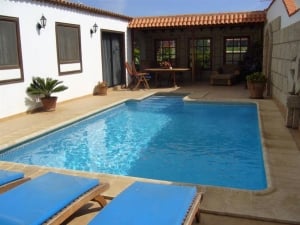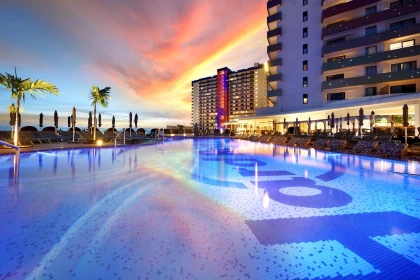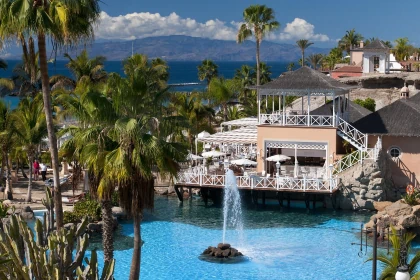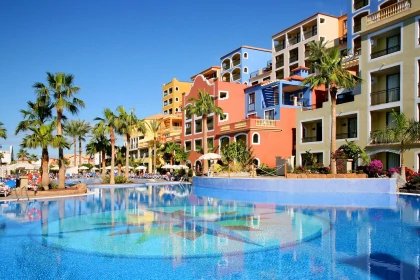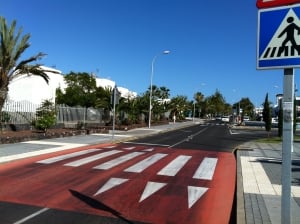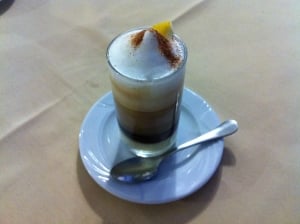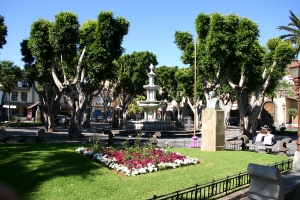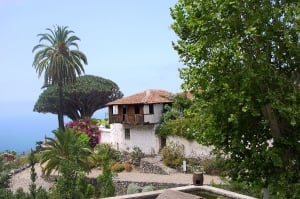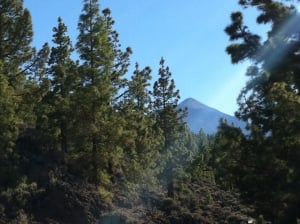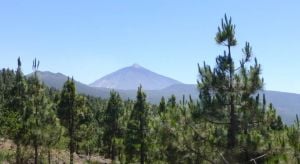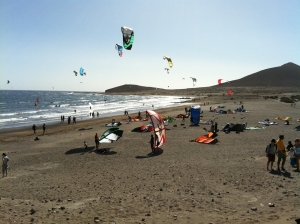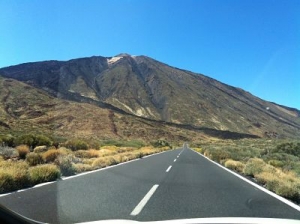
This article was by written Peter Allan
Peter fist visited Tenerife in 1982 staying in Puerto de la Cruz, and is now a habitual visitor to the island having become fascinated by its diversity, spending in excess of 8 weeks a year there. He has travelled all around the island staying in the lesser known resorts and towns, and has a particular interest in the history of Tenerife.
Types of Accommodation in Tenerife
The Canary Islands are Europe’s most popular winter sun destination; Tenerife is the most popular of the Canary Islands with more visitors than the other islands. There are hundreds of hotels and thousands of privately owned apartments and timeshare complexes in the coastal resorts.
It is normally much cheaper to book you package holiday or flights and accommodation well in advance.
Self-catering Accommodation
Renting one of the numerous privately owned apartments or timeshare self-catering apartments can be a very economical way to stay and often can be rented at very short notice. The accommodation ranges from basic studios, one and two bedroom apartments to small villas and large luxury villas.
Apartments in TenerifeHotels
Many hotels have allocated their rooms to the tour operators, but it is still possible to book accommodation independently, especially now the recession has hit the tourist industry and the major tour operators are cutting back on their allocation. It may be more difficult to find accommodation during the high seasons at Christmas, Easter and the summer holiday period.
Most of the tourist hotels are modern and situated in purpose build resorts such as Playa de las Americas, but there are some charming old hotels in traditional Canarian buildings with the Spanish colonial style court yards and wooden balconies in the older resorts like Puerto de la Cruz.
Hotels build during the 60’s and 70’s are not very attractive, but in recent years there has been a concerted effort to build mort aesthetic architecture and the result is lower rise and more diverse buildings with large gardens and swimming pools.
Hotels in TenerifeBudget Accommodation
There is plenty of budget accommodation on the island in hostal’s and pensión’s, the quality of which can vary quite a bit. Be aware that the budget accommodation can attract people who may be a bit noisy and may want to party late, this will also depend on the time of year with the high season attracting more revelry.
Places to Stay in Tenerife
The East Coast of Tenerife
Arriving at Tenerife’s south airport couldn’t give the new visitor to the island a worse first impression. The landscape is arid and baron, unattractive industrial estates surround the airport and numerous large plastic greenhouses abound under which bananas are grown.
However, you only need to go a few miles inland and the scenery improves, where there are some nice market towns and extensive forest.
Visitors landing at Tenerife’s north airport gat an altogether different picture of the island where it is lush and green.

The east coast of Tenerife has a handful of small coastal towns and resorts. Close to Tenerife south airport is El Medano, which is a small typically Spanish developing town and is very popular with windsurfers due to the persistent winds here. There is also a natural sand beach here and round the Roque Roja.
Just along the coast from here is Los Abrigos, a small fishing village that has escaped the tourist building boom and has some of the best fish restaurants on the island.
Next to Los Abrigos is the purpose built tourist area of Golf de Sur which as its name suggests has two great 18 hole championship golf courses and are some of the best on the Canary Islands.

Further along you come to Costa del Silencio, another purpose built town for tourists, but right next to this is the fishing village of Las Galletas where there are some very good fish restaurants along the promenade and around the marina.
Further up the coast towards Santa Cruz the in the town of Candelaria which is the destination of pilgrims from far afield to see the image of St Candelaria in the church here. Very close to here is the town of Las Caletillas where there is a very nice promenade and some fine Spanish restaurants.
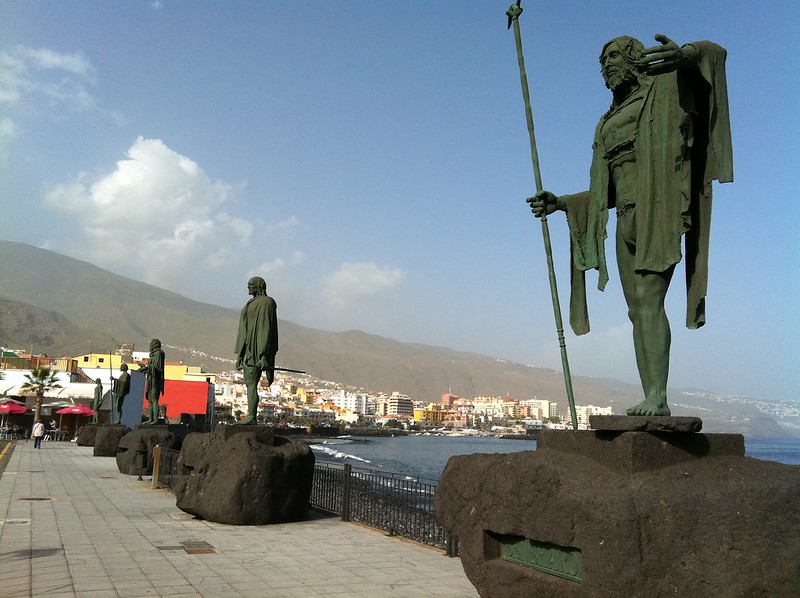
Getting Around Tenerife
Tenerife is not a big island, but driving can be slow on the often winding and narrow roads especially on the mountain roads. The exception is the TF1 motor way which connects the island from Santa Cruz to Playa de las Americas in the south and Puerto de la Cruz in the north.
Buses
There is a good bus service operating all over the island and is operated by TITSA. The bus service connects the towns and villages, but often the bus service does not go in to the towns and you are dropped off at stops along the TF1 motorway. You may then need to get a local bus, if there is one, walk or get a taxi. Busses do go into the main towns, but check by getting yourself an up to date bus map.
Driving
Driving is on the right in Tenerife. The speed limit is 40kph in the built up areas, 100kph on main roads and 120kph on the motorway. Seat belts must be worn by all passengers including the ones in the rear. Traffic offence fines can be very high and as a foreigner you may be forced to pay on the spot. Beware of some drivers who may be impatient to pass you, especially on the mountain roads, they have knowledge of the roads, you don’t, and there are some perilous drops. The condition of the roads is very good.
Entering the motorway can be a bit nerve racking as the motorway only has two lanes and very short entry slip roads, always give way to the traffic on the motorway and don’t assume they will move over in to the outside line to allow you entry to the motorway. Petrol is a lot cheaper than the UK and the Spanish main land due to the special tax status of Tenerife. Petrol stations are available 24hrs in the main towns and are plentiful on the main roads, but many close on Sundays and public holidays. Make sure you have a full tank if you are driving into the mountains as there are few petrol stations in the remote areas.
Taxis
Taxis are plentiful in the resorts and are not expensive for short journeys. Make sure the meter is reset before you journey. Longer trips can work out expensive, make sure you negotiate a price before you journey begins.
Walking
Walking on Tenerife is growing in popularity with superb walks on the Parque Nacional del Teide and the Anaga Mountains. New trails have recently been opened for hikers and walkers.
Bicycles
Cycling is a great way to get around the island, you can hire bikes in the most visited areas. You will need to be fit to deal with some of the mountain areas, but you can cycle around the coastal areas which are relatively flat. Make sure you carry plenty of water.
Tenerife Food and Drink
Located just off the Northern Atlantic coast of Africa, the Canary Islands are a popular vacation destination due to the pleasant climate and beautiful coastlines. Tenerife in particular has a unique blend of weather, culture, and history that meshes together to form some of the most delicious and original cuisine in the world. The food and drink in Tenerife is something that shouldn't be missed, although sometimes it's necessary to get away from some of the more built up, touristy locations to really get a taste of the local dishes.
Weather and History
The weather in Tenerife is generally pleasant all year round, with an average temperature of 15C in winter and 24C in summer; however, it can get a lot hotter than this. The main advantage of such a warm climate is that fruit and vegetables can be cultivated all year long. With this in mind, Tenerife's dishes are loaded with watercress, green beans, olives, zucchinis, and tomatoes, as well as tropical fruits like papaya, guava, mangos, bananas, and avocados. These are all used heavily in the island's typical dishes which helps to ensure that each restaurant’s menu is colourful and bursting with flavour.
Seafood
No island cuisine would be complete without a healthy portion of freshly caught seafood. On this note, tourists can expect to have the option to sample fresh fish such as tuna and mackerel, as well as crab, lobster, calamari and eel; much of it caught that very same day. On top of that, several of the restaurants, such as the La Torre del Mirador sport live fish tanks that allow visitors to hand pick their meal. One of the local favourites is called Cazuela de Pescado, which is fresh caught fish in a casserole along with peppers, onions, potatoes, and tomatoes. It is hearty and filling, perfect after a long day exploring the city.
Other Popular Dishes
The blend of cultures on the island includes European, Spanish, African, and Latin American, each contributing to the unique flavour of the local dishes. This means that there will be a dish to suit every taste. One popular ingredient is gofio, which is a type of flour made from roasted grains. Gofio is a staple of the Canary Islands and is used in everything from stews to cereals and even ice creams. Other popular options include Papas Arrugadas which are potatoes that have been boiled and salted while still in their skin; Potaje de Berros which is a hot pot of chickpeas; and Tapas which is a popular Spanish light dish that is found everywhere on Tenerife.
Beer and Wine  Barraquito
Barraquito
What vacation would be complete without a few glasses of local national beer or vintage wine? The national beer of Tenerife is named Dorada, and the only other place this beer can be found is Gran Canaria, the neighboring island. All Dorada beer is brewed on the island. Alternatively, Gran Canaria’s own beer is called Tropical and is
usually available in bars in Tenerife. On a side note, Tenerife hosts five major wine producing regions, so like the beer, all the wine is actually produced locally. Of course, there are the traditional beverages available from around the world as well.
Island food always seems to have a spice and flavour all of its own, no matter what part of the world it's in. However, the food and drink in Tenerife is by far one of the best cultural experiences out there.
La Laguna Tenerife
The city of La Laguna is Tenerife’s oldest settlement being founded by Alfonso Ferdández in 1496 after he had conquered the island. It is here that the Guanches were finally defeated. The town was the capital of Tenerife until 1723 when Santa Cruz took over that roll.
La Laguna is situated 550m above sea level and the climate is somewhat cooler than on the coast. The city got its name from a lagoon that was here, but it was drained in 1837 then filled in and built over. La Laguna has been a UNESCO world heritage site since 2000 due to its historical old town to the north, where its shopping and commercial centre is located. This part of the town still retains its original street plan and is full of historical buildings made of stone, with patios full of flowers and typical Canarian wooden balconies.

The old town is full of convents, monasteries and churches. To the south of the city centre is the modern part of La Laguna, where the university and the Science and Technology Museum is situated and contrasts with the ancient northern part of the city. The university is home to around 13000 students and they create a lively atmosphere in the city.

The Canarian Astro Physics Institute is associated with the university, and the observatories on Mount Teide and on La Palma are run by the institute. The Museum of Science and the Cosmos is also owned by the university, and there are some fascinating hi-tech hands on presentations. For example you can take a lie detector, see your own skeleton and communicate with outer space.
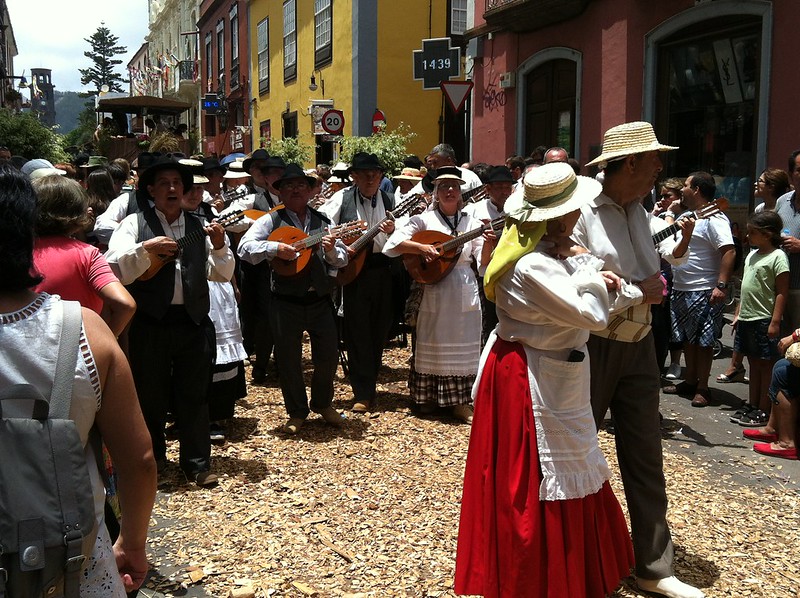
The city doesn’t attract many tourists, which is a bit strange, as it is a fascinating historical city and is one of Tenerife’s gems.
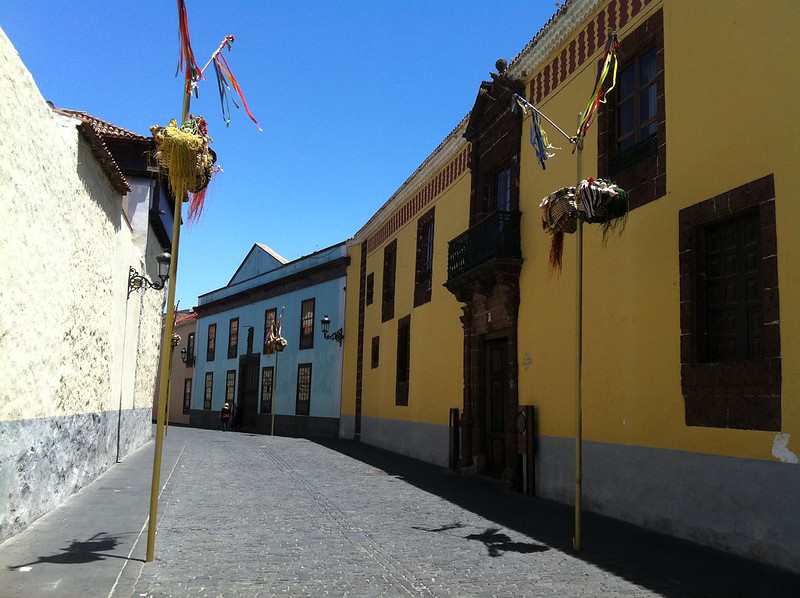
Where is La Laguna
La Laguna is situated in north Tenerife in the Aguere Valley above the capital city of Santa Cruz and close to the north Tenerife airport of Los Rodeos. La Laguna is approximatley 78km by road from Playa de las Americas and will take about 1 hour.
Icod de los Vinos Tenerife
The small town of Icod de los Vinos is in the centre of the wine growing area of Tenerife and the hills behind the town are full of terraces growing vines. Icod de los Vinos and has its own wine festival in November, the Festival of San Andrés, when the wineries have an open day and the custom is for the youths to hurl themselves down the steep Calle Calvario on wooden sledges. This tradition is believed to have originated from the times when logs were rolled down the hill to the Bay of Marcos for the construction of ships.

Icod is most famous though for its ancient Dragon Tree that is reputed to be over 1000 years old and stands at 16 m tall and 6m in diameter. The Dragon Trees sap turns red on contact with the air and was known as dragon’s blood in medieval times and was used for medicinal purposes. The sap was also used as a natural dye to varnish musical instruments, stain marble and was also used as a cosmetic. It is believed that the Guanche people administered justice from beneath its branches and that the Guanche held their Dragon Tress in high reverence.
Around the Dragon Tree is a small botanical garden that includes several young Dragon Trees that look rather insignificant next to the old boy.

There is a lot more to see in Icod. There is the 16th century church of San Marcos near the dragon tree set in a shaded square with laurels and palms. Take a look inside where there is a huge cross from Mexico which is 2m high and is thought to be the largest silver filigree cross in the world.
Take the steep lane from the church to the Plaza de la Constitución where you will find the square that looks just as it would have done 200 years ago. This is one of the finest squares on Tenerife with a fountain surrounded by palms, laurels and oleander. The square is full of fine old trees and ancient buildings and bodegas. Here there is also a Doll and Puppet Museum located in a Canarian mansion.
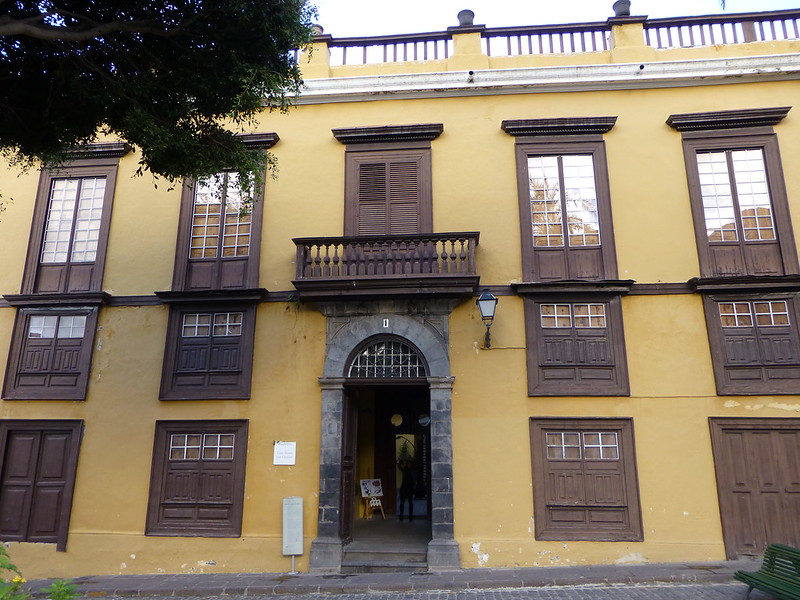
Below the Plaza is the Mariposario del Drago butterfly Zoo, where hundreds of exotic butterflies for all over the world can fly around in total freedom in a beautiful garden. You can see the whole life cycle from egg to butterfly.
Just down the hill from here is the village of Playa de San Marcos, which is now developing into a resort. Here you will find a small back sand beach with a promenade with bars and restaurants, and is a nice place to relax with a drink and enjoy the sun and sea breezes.
Where is Icod de los Vinos
Icod de los Vinos is located in north west Tenerife close to the costal village of Garachico. It is an inland town and is at an altitude of 253 meters, its position is shown on the map below.
Icod de las Vinos Rentals
See map for Hotels, Villas and Apartments in Icod de las Vinos. Choose the travel dates for your Tenerife holidays to see availability and prices of accommodation.
Booking.comMount Teide Tenerife
Mount Teide dominates Tenerife and can be seen from all over the island, and is a must visit for any visitor to Tenerife. In winter the temperatures drop below freezing, and in the summer if there is a wind blowing it can be cold. Conditions can change rapidly, a warm morning can turn into a freezing afternoon. You should always take a warm jacket, trousers and hiking boots, along with your sunglasses, sun block and a hat.
There is a cable car that will take you to the peak of Teide from the caldera were there are stunning views of the whole of the Canary Islands.
In winter Teide is often covered in snow and you can ski there when the conditions are right.
Mount Teide Goelogical History
Tiede is a stratovolcano that grew out of the Canadas caldera about 600,000 years ago. The Tide complex is not extinct as you may read elsewhere, but is an active volcano that is currently dormant; the last eruption was in 1909 from the El Chinyero vent. An eruption from the Mountanas Negras in 1706 destroyed the town of Garachico and several small villages.

Tiede stands at 3718 m/12,195ft above sea level and is the highest mountain in Spain and of the Atlantic islands. It is the 3rd largest volcano in the world, measured from its base on the sea floor it stands at 7500m. Teide has been designated a decade volcano as a volcano of special interest, due to its proximity to large human populations and history of destructive eruptions.
Teide is just the latest of several volcanos to soar above Tenerife and stands in the Canadas Caldera which is the remains of a previous much larger volcano that is thought to have undergone a catastrophic collapse. Tiede and its sister volcano Pico Viejo (3134m) have erupted from the floor of the caldera on its northern edge.

In recorded history the eruptions have been from the NW rift at Boca Cangrejo in 1492, Montañas Negras in 1706, Narices del Teide in 1798 and El Chinyero in 1909. The NE rift had volcanic eruptions in 1704 and 1705.
Teide National Park was declared a UNESCO World Heritage site in June 2007.
Tenerife Top 10 Attractions
Mount Teide: Tenerife’s main attraction, the Las Cañadas caldera and the Teide volcano, the highest Spanish mountain. Dramatic lunar scenery and national park. Spain’s highest mountain, take the cable car up to the peak.
Parque Nacional de las Canadas del Teide: the park around Teide, used for film sets and full of amazing scenery.
Museo de la Naturaleza y el Hombre: the best museum in Tenerife, Santa Cruz.
Playa de las Teresitas: the best beach on Tenerife manmade with golden sand from the Sahara desert, near Santa Cruz.
La Orotava old town: The best examples of old Spanish colonial architecture on the island. Visit the old town with its ancient streets and Canarian buildings with traditional wooden balconies and court yards.
Punta de Teno: The wild western point of Tenerife. Fantastic views down the Teno Massif and across to La Gomera.
Masca: A hamlet perched on the slopes of the Teno Massif untouched by time.
The Cliffs of Los Gigantes: The cliffs are an awesome sight and are the result of Tenerife’s natural history that being volcanic eruptions and coastal erosion.
Anaga Mountains: These are the rugged mountain terrain on the north eastern tip of Tenerife that is covered in dense forest with nature trails you can walk. There are some charming villages untouched by tourism.
Garachico: The old port destroyed by volcanic eruption. The village is charming, with its rock bathing pools and old convent.
Tenerife Beaches
Tenerife has a reputation for sun, sea and sand, so it may be surprising to learn that there are very few natural Tenerife beaches. The natural beaches there are, are formed of black volcanic sand, pebble and volcanic rock. Many visitors are disappointed that the golden sand of the Mediterranean is absent.
Tenerife has worked hard to counteract this natural shortcoming by importing a massive amount of sand from the Sahara desert to create artificial beaches and have created seawater pools to swim in safety.
Tenerife has nearly 400km of coast line bathed by the Atlantic Ocean and the beaches usually have amenities for bathers. Some beaches are enough calm where you can take a dip with the family, or wild and windy where the surfers rule.
Playa de las Teresitas is the undoubtedly the best on the island. It is entirely manmade from sand imported from the Sahara desert in the 1970’s. A manmade stone reef protects the beach from storms and ensures safe swimming. The beach is 2km long and has plenty of facilities including palm trees to provide shade, beach bars, pedaloes and a wind surfing school.
Playa de las Americas has three small manmade beaches of sand imported from the Sahara desert that are well kept and clean. Backing the beaches is a palm tree lined promenade with cafés, bars and restaurants, many serving excellent food. The beach at Playa de las Vistas is very impressive and has an off shore fountain.
El Médano has the best of the natural beaches on Tenerife and is comparatively wild and empty. The beach here catches the full force of the trade winds and has become a haven for windsurfers.
There are some glorious Tenerife beaches but they are few in number and the best ones are manmade. There is however some totally unspoilt natural beaches of black sand that remain hidden from the uninformed tourist.
Where the coast is rugged there has been created some wonderful natural seawater swimming pools at places such as Los Gigantes, Garachico, Bajamar and Punta del Hidalgo and theLago Martiánez in Puerto de la Cruz and César Manrique in Santa Cruz which were both designed by the Canarian artist César Manrique.
Driving on Tenerife
The roads in Tenerife are, for the most part, in good condition. The traffic is lighter than in the UK. The exceptions are in the city areas and some junctions approaching the TF1 motorway during rush hour.
The TF1 motorway links the island from Adeje and the southern resorts and runs to the south tip of the island, following the eastern coast up to Santa Cruz in the northeast. From here, it goes north past La Laguna and back down to the island's northern coast, heading west past Puerto de la Cruz and ending at Los Realejos. The TF1 motorway is currently being extended from the western coast to the north.
Some roads in the mountains twist and turn with some precarious hairpin bends over high cliffs, and there is often mist and fog at altitude. Some petrol stations in rural areas are closed on Sundays and public holidays.
Frequently Asked Questions About Driving In Tenerife
What Side Of The Road Do You Drive In Tenerife?
On Tenerife, we drive on the right-hand side of the road, the same as in Spain and mainland Europe, with the driver controls fitted on the left side of the car.
Do You Have To Wear Seat Belts When Driving In Tenerife?
Wearing seat belts is compulsory; children under 3 years old must travel in fixed child seats, and children under 12 must not travel on the front seats.
What Are The Speed Limits In Tenerife?
Speed limits on Tenerife are as follows: towns 50km/31mph, rural roads 90km/55mph and motorways 120km/74mph.
Do Motorcyclists Have To Wear Helmets In Tenerife?
Motorcyclists must wear crash helmets when riding a scooter or motorcycle.
Can The Police Issue On-The-Spot Fines In Tenerife?
Motoring offences are penalised with on-the-spot fines, and visitors are subject to substantial penalties. Breath tests are carried out randomly, and the blood alcohol limit is 0.08%.
Do you Need An International Driving Permit To Drive In Tenerife?
You do not need an International Driving Permit to drive in Tenerife if you have a photocard driving licence issued in the UK.
How Old Must You Be To Hire A Car On Tenerife?
You must be at least 21 years old and have held a driving licence for over a year; you will also be required to produce a valid licence.
Are There Parking Restrictions In Tenerife?
There are parking restrictions on busy streets in Santa Cruz, Playa de las Americas and Puerto de la Cruz; you will need to buy a pay and display parking ticket or risk your car being towed away.

